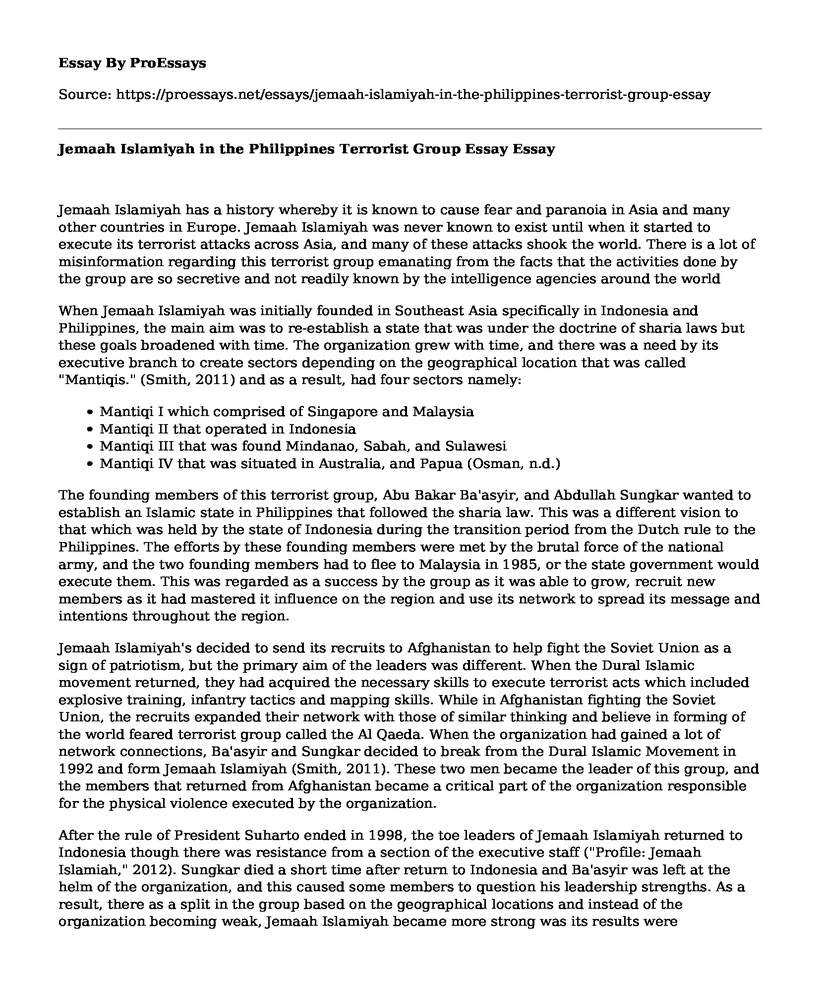Jemaah Islamiyah has a history whereby it is known to cause fear and paranoia in Asia and many other countries in Europe. Jemaah Islamiyah was never known to exist until when it started to execute its terrorist attacks across Asia, and many of these attacks shook the world. There is a lot of misinformation regarding this terrorist group emanating from the facts that the activities done by the group are so secretive and not readily known by the intelligence agencies around the world
When Jemaah Islamiyah was initially founded in Southeast Asia specifically in Indonesia and Philippines, the main aim was to re-establish a state that was under the doctrine of sharia laws but these goals broadened with time. The organization grew with time, and there was a need by its executive branch to create sectors depending on the geographical location that was called "Mantiqis." (Smith, 2011) and as a result, had four sectors namely:
- Mantiqi I which comprised of Singapore and Malaysia
- Mantiqi II that operated in Indonesia
- Mantiqi III that was found Mindanao, Sabah, and Sulawesi
- Mantiqi IV that was situated in Australia, and Papua (Osman, n.d.)
The founding members of this terrorist group, Abu Bakar Ba'asyir, and Abdullah Sungkar wanted to establish an Islamic state in Philippines that followed the sharia law. This was a different vision to that which was held by the state of Indonesia during the transition period from the Dutch rule to the Philippines. The efforts by these founding members were met by the brutal force of the national army, and the two founding members had to flee to Malaysia in 1985, or the state government would execute them. This was regarded as a success by the group as it was able to grow, recruit new members as it had mastered it influence on the region and use its network to spread its message and intentions throughout the region.
Jemaah Islamiyah's decided to send its recruits to Afghanistan to help fight the Soviet Union as a sign of patriotism, but the primary aim of the leaders was different. When the Dural Islamic movement returned, they had acquired the necessary skills to execute terrorist acts which included explosive training, infantry tactics and mapping skills. While in Afghanistan fighting the Soviet Union, the recruits expanded their network with those of similar thinking and believe in forming of the world feared terrorist group called the Al Qaeda. When the organization had gained a lot of network connections, Ba'asyir and Sungkar decided to break from the Dural Islamic Movement in 1992 and form Jemaah Islamiyah (Smith, 2011). These two men became the leader of this group, and the members that returned from Afghanistan became a critical part of the organization responsible for the physical violence executed by the organization.
After the rule of President Suharto ended in 1998, the toe leaders of Jemaah Islamiyah returned to Indonesia though there was resistance from a section of the executive staff ("Profile: Jemaah Islamiah," 2012). Sungkar died a short time after return to Indonesia and Ba'asyir was left at the helm of the organization, and this caused some members to question his leadership strengths. As a result, there as a split in the group based on the geographical locations and instead of the organization becoming weak, Jemaah Islamiyah became more strong was its results were catastrophic when planning and executing its attacks.
Conclusion
The death toll caused by this organization are in several hundred with the largest had 202 casualties that were masterminded in 2002 in the Bali Club; 3 casualties and 129 persons injured in 2004 bombing at the Australian Embassy, Jakarta; 20 casualties and 129 persons injured in 2005 suicide bombings in Bali (("Jemaah Islamiyah (JI) | Australian National Security," n.d.). These bombing by this terrorist organization have achieved to put them in the same league as Al Qaeda as they have been fatal.
References
Jemaah Islamiyah (JI) | Australian National Security. (n.d.). Retrieved from http://www.nationalsecurity.gov.au/Listedterroristorganisations/Pages/JemaahIslamiyahJI.aspx
Osman, M. N. (n.d.). Regionalization of Terrorism: Jemaah Islamiyah in South East Asia. Terrorism: Patterns of Internationalization, 175-190. doi:10.4135/9788132102205.n9
Profile: Jemaah Islamiah. (2012, February 2). Retrieved from http://www.bbc.com/news/world-asia-16850706
Smith, G. (2011). The Bali Paradox: An Examination of Jemaah Islamiyah 1992-2002. doi:10.21236/ada628356
Cite this page
Jemaah Islamiyah in the Philippines Terrorist Group Essay. (2022, Jul 19). Retrieved from https://proessays.net/essays/jemaah-islamiyah-in-the-philippines-terrorist-group-essay
If you are the original author of this essay and no longer wish to have it published on the ProEssays website, please click below to request its removal:
- Alcoholics Anonymous and Twelve Step Programs Essay
- Essay Sample on Similarities and Differences Between Marijuana and LSD
- Essay Example on Al Qaeda: A Notorious Militant Group since the 1990s
- Essay Sample on Racism in Human Society: Orelu's Prioritization of Meaningful Factors
- Essay Example on Poverty's Impact on Today's Issues of Violence
- Athens Defeats Persia in First Persian War - Essay Sample
- Essay Sample on Whether Abortion is Morally Justifiable







